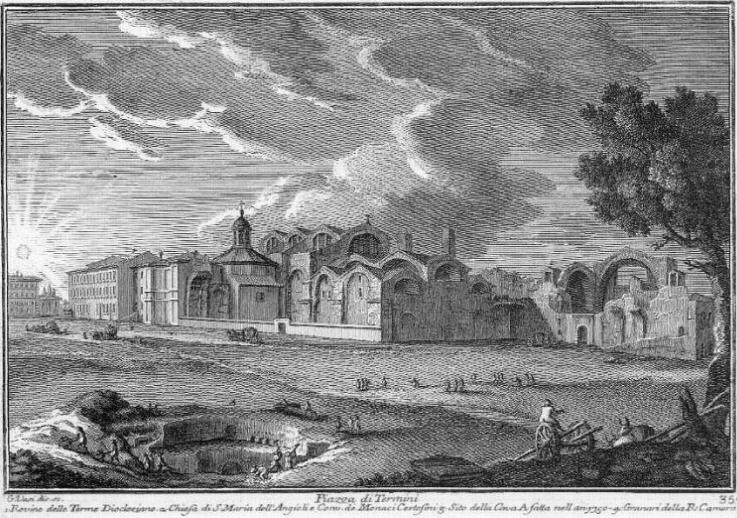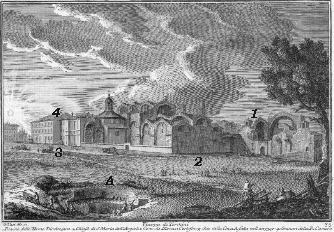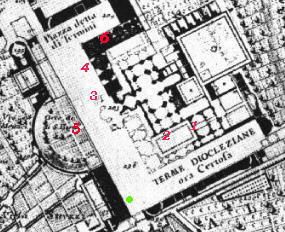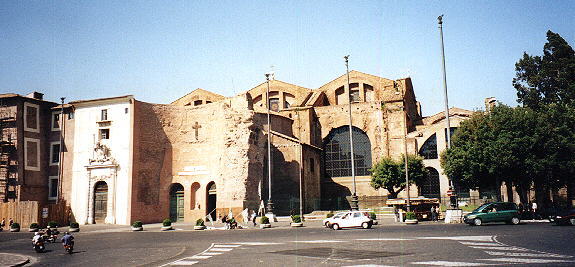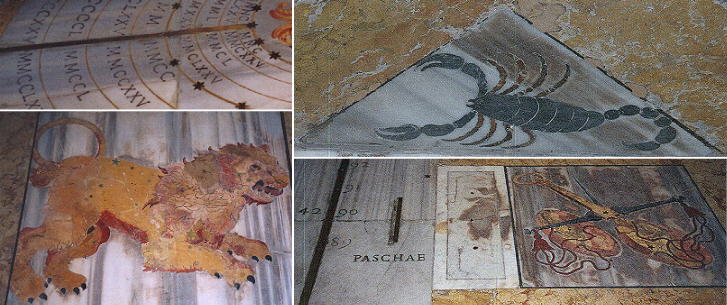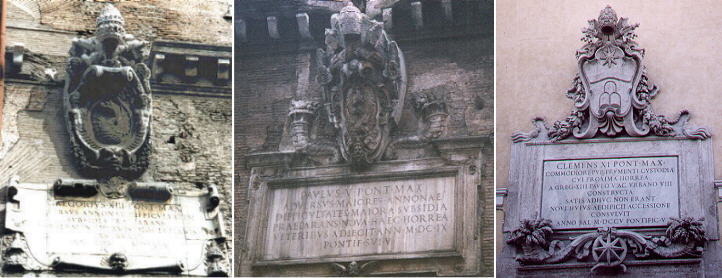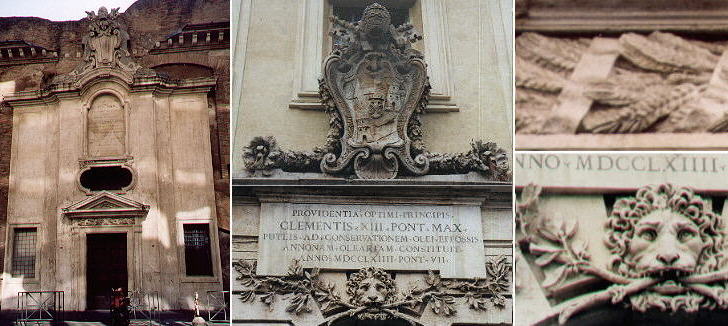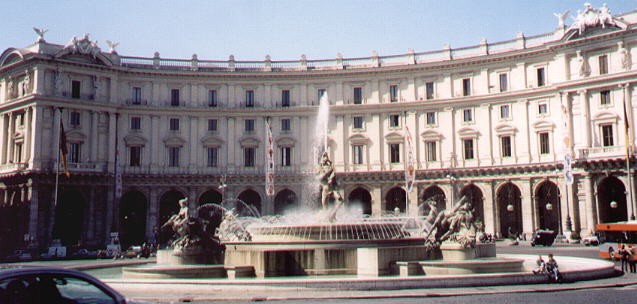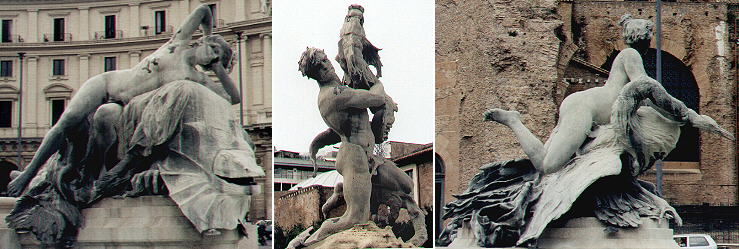  Piazza di Termini (Book 2) (Map A2) (Day 2) (View B7) (Rione Monti) In this page:
Termini is today the word used to designate the Central Railway
Station of Rome, just as in London you say Euston or Waterloo. The name comes
after the Thermae (baths) built at the beginning of the IVth century by
Diocletian. The piazza is actually inside the main building of the
baths. Near piazza di Termini Sixtus V built his
villa. The view is taken from the green dot in the 1748 map here below. In the description below the plate Vasi made reference to: 1) Rovine (ruins) delle Terme Diocleziane; 2) Chiesa di S. Maria degli Angeli;
3) the site of excavations made in 1750, which are shown in detail in A; 4) Granaries. The small map shows also 5) Fontana delle Najadi; 6) S. Isidoro in Thermis.
Today a key traffic roundabout (rotary), Piazza di Termini is called Piazza della Repubblica or Piazza Esedra because of its exedra (semicircular) shape. The church of S. Maria degli Angeli was substantially altered by Luigi Vanvitelli in 1749, just before the time of Vasi's plate by changing its orientation: this change was nearly a sacrilege, as the church had been designed by Michelangelo who gave it a Greek cross shape with the Tepidarium of the baths being used as the main nave (at the time the Tepidarium because of its dimensions was thought to be a sort of museum and was referred to as la Pinacoteca - the picture-gallery), and two Calidaria as the left transept and the right transepts. At the beginning of the XXth century Vanvitelli's façade was demolished to bring back to light the original walls of the Calidarium (a small part of the façade can be seen on the left).
The current transept of the church was the nave of the church designed by Michelangelo. The entrance was from this wall. In 1703 Clemens XI built a sundial, where it is not the shadow which shows the time, but the light. At the astronomical noon a sunbeam, entering the church from a coat of arms near the ceiling, crosses a meridian line drawn on the floor. The crosspoint differs according to the various periods of the year which are indicated by mosaics showing the signs of the zodiac and the stars of the related constellation. The sundial allows also the calculation of Easter and the position of the Pole-star. The choice of S. Maria degli Angeli, a church rather remote from the center of papal Rome, was due to the stability of the walls of the church, then some 1,400 years old. As a matter of fact the sundial is still accurate.
The Granaries of the Popes and S. Isidoro in Thermis At point 4. in the plate Vasi quotes the granaries of Rome. These were built by Gregorius XIII using the large rooms of the baths. To celebrate this accomplishment he put on the external walls (today in Via Parigi) his coat of arms with an explanatory inscription. A few years later Paulus V had to enlarge and restore the granaries and felt obliged to leave a coat of arms and another inscription. At the beginning of the XVIIIth century Clemens XI came to the conclusion that the granaries were not up to the needs of the city. Thus additional space was obtained in another part of the ruins and a gigantic coat of arms completed the task.
For the Holy Year 1750 Benedictus XIV turned one of the rooms of the ancient baths into a little chapel (S. Isidoro in Thermis), by covering the Roman walls with a Baroque façade. In 1764 Clemens XIII added a depot for storing olive oil and celebrated the event with a large coat of arms. Because most of the inhabitants of Rome were not able to read the inscriptions, sheaves of wheat and branches of olive-trees provided an alternative means of making known the purpose of the buildings.
After the annexation of Rome to the Kingdom of Italy in 1870, the new government made Piazza di Termini the center of the expansion of the city required by its new role as capital of a large country. In 1885 a large fountain was designed at the center of the square and at the beginning of the XXth century the sculptor Mario Rutelli decorated it with four Naiads (water-nymphs) in the act of subduing sea monsters. At a later stage Rutelli added a man holding a gigantic fish spouting water. Usually the many streams of spouting water of the fountain do not allow a clear view of the statues. During the maintenance of the fountain it is possible to understand why Rutelli's Naiads were so criticized and charged with being (in today's words) soft-porn. The subject of the central group instead is more consistent with other Roman statues (in particular Fontana del Moro by Bernini).
Excerpts from Giuseppe Vasi 1761 Itinerary related to this page:
Next plate in Book 2: Piazza delle Quattro Fontane Next step in Day 2 itinerary: Porta Pia Next step in your tour of Rione Monti: Villa Peretti
Go
to |
